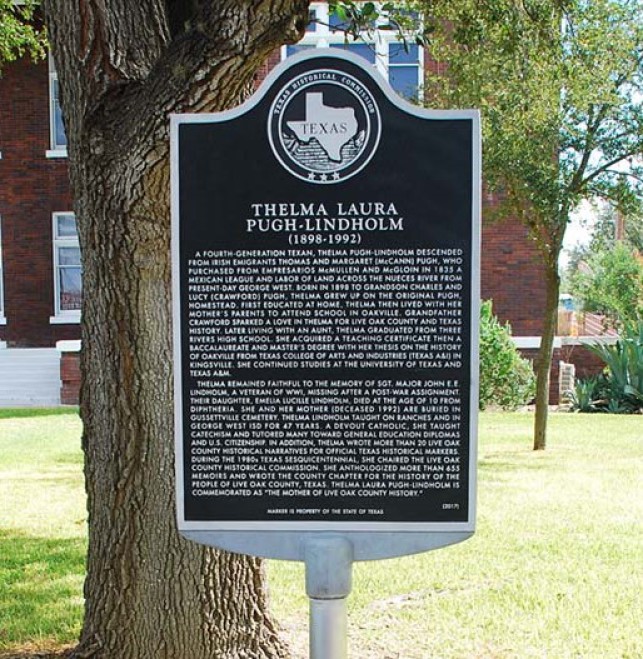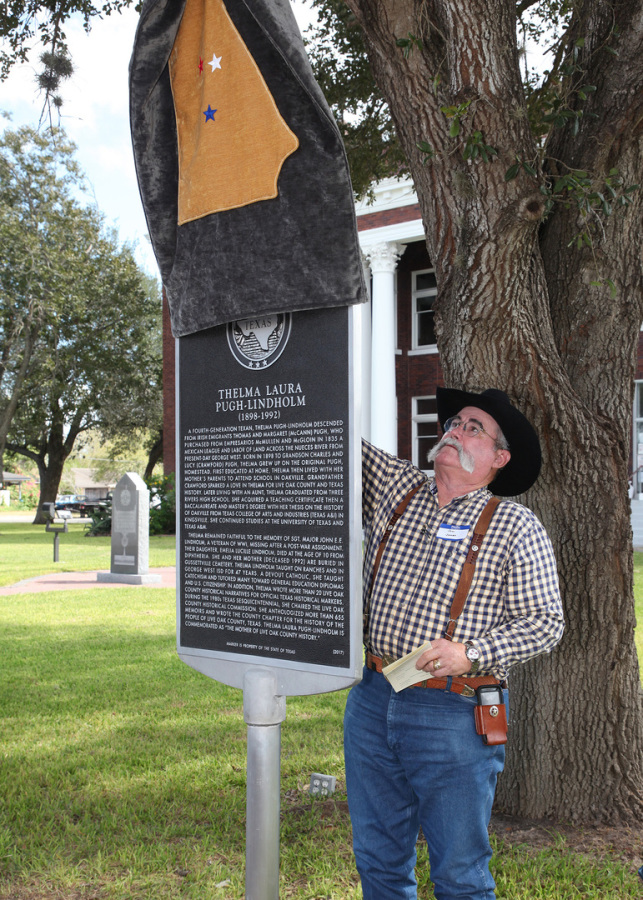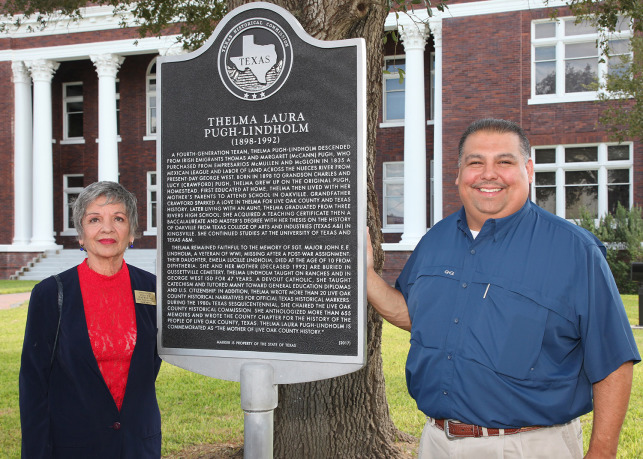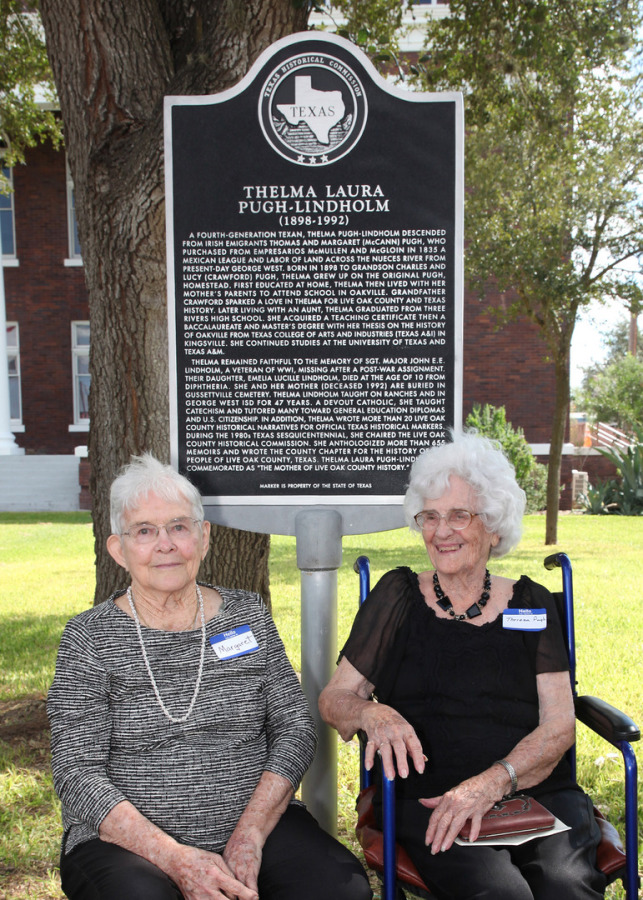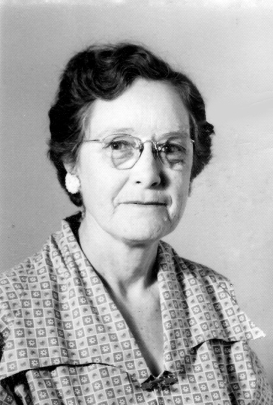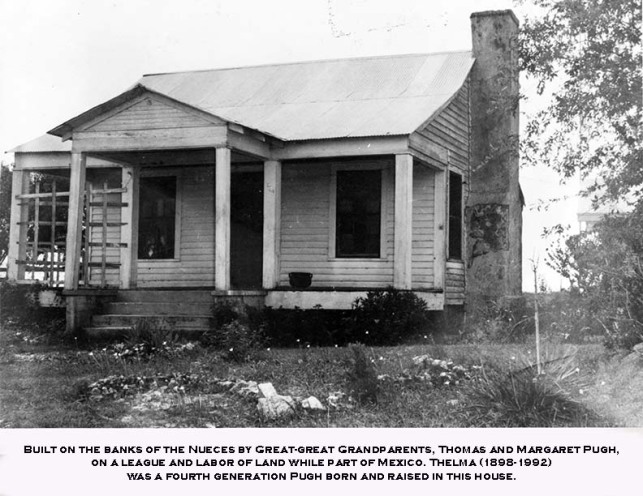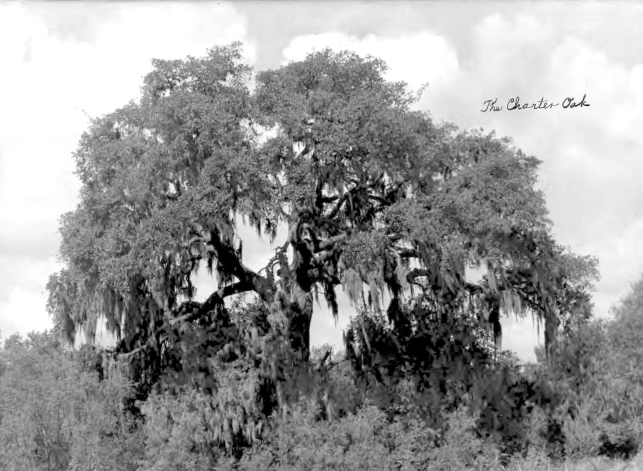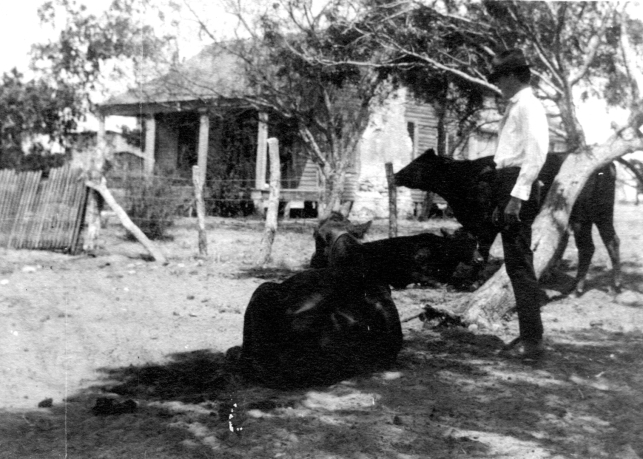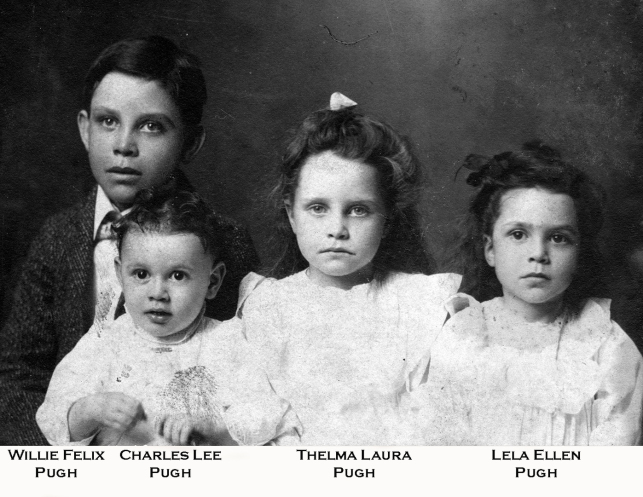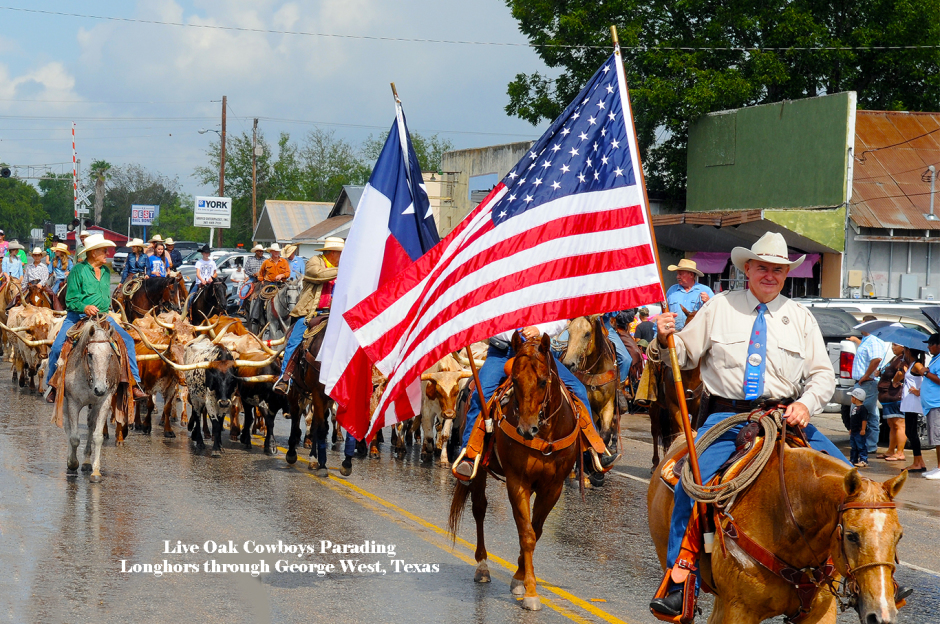
Thelma Laura Pugh-Lindholm Mother of Live Oak County History
Thelma Laura Pugh-Lindhom endeared herself as a public school teacher who began soon after graduating from Three Rivers, Texas as a teen. A thriving interest in history embedded while she lived with her Grandfather and Grandmother Crawford prepared her to share the county's rich legacy. Photo courtesy Richard Hudson.
Live Oak County Judge: Honorable Jim Huff
Live Oak County Historical Commission Chair: Ross Harris
LOCHC Marker Chair: Richard Hudson
Assistant Chair: Janis Hudson
Lindholm Marker Sponsor: Thomas and Margaret Pugh Family Descendants - Peggy Hillje, Family Coordinator.
Date Unveiled: 2017
Contact: rehudson@liveoakchc.com
Pugh Lindholm Texas Historic Subject Marker text:
THELMA LAURA PUGH-LINDHOLM (1898-1992)
A FOURTH-GENERATION TEXAN, THELMA PUGH-LINDHOLM DESCENDED FROM IRISH EMIGRANTS THOMAS AND MARGARET (McCANN) PUGH, WHO PURCHASED FROM EMPRESARIOS McMULLEN AND McGLOIN IN 1835 A MEXICAN LEAGUE AND LABOR OF LAND ACROSS THE NUECES RIVER FROM PRESENT-DAY GEORGE WEST. BORN IN 1898 TO GRANDSON CHARLES AND LUCY (CRAWFORD) PUGH, THELMA GREW UP ON THE ORIGINAL PUGH HOMESTEAD. FIRST EDUCATED AT HOME, THELMA THEN LIVED WITH HER MOTHER'S PARENTS TO ATTEND SCHOOL IN OAKVILLE. GRANDFATHER CRAWFORD SPARKED A LOVE IN THELMA FOR LIVE OAK COUNTY AND TEXAS HISTORY. LATER LIVING WITH AN AUNT, THELMA GRADUATED FROM THREE RIVERS HIGH SCHOOL. SHE ACQUIRED A TEACHING CERTIFICATE THEN A BACCAQLAUREATE AND MASTER'S DEGREE WITH HER THESIS ON THE HISTORY OF OAKVILLE FROM TEXAS COLLEGE OF ARTS AND INDUSTRIES (TEXAS A&I) IN KINGSVILLE. SHE CONTINUED STUDIES AT THE UNIVERSITY OF TEXAS AND TEXAS A&M.
THELMA REMAINED FAITHFUL TO THE MEMORY OF SGT. MAJOR JOHN E.E. LINDHOLM, A VETERAN OF WWI, MISSING AFTER A POST-WAR ASSIGNMENT. THEIR DAUGHTER, EMELIA LUCILLE LINDHOLM, DIED AT THE AGE OF 10 FROM DIPHTHERIA. SHE AND HER MOTHER (DECEASED 1992) ARE BURIED IN GUSSETTVILLE CEMETERY. THELMA LINDHOLM TAUGHT ON RANCHES AND IN GEORGE WEST ISD FOR 47 YEARS. A DEVOUT CATHOLIC, SHE TAUGHT CATECHISM AND TUTORED MANY TOWARD GENERAL EDUCATION DIPLOMAS AND U.S. CITIZEBNSHIP. IN ADDITION, THELMA WROTE MORE THAN 20 LIVE OAK COUNTY HISTORICAL NARRATIVES FOR OFFICIAL TEXAS HISTORICAL MARKERS. DURING THE 1980s TEXAS SESQUICENTENNIAL, SHE CHAIRED THE LIVE OAK COUNTY HISTORICAL COMMISSION. SHE ANTHOLOGIZED MORE THAN 655 MEMOIRS AND WROTE THE COUNTY CHAPTER FOR THE HISTORY OF THE PEOPLE OF LIVE OAK COUNTY, TEXAS. THELMA LAURA PUGH-LINDHOLM IS COMMEMORATED AS "THE MOTHER OF LIVE OAK COUNTY HISTORY." (2017) MARKER IS THE PROPERTY OF THE STATE OF TEXAS.
APPLICATION NARRATIVE and BIBLIOGRAPHY FOR OFFICIAL TEXAS HISTORICAL SUBJECT MARKER:
THELMA LAURA PUGH LINDHOLM
MOTHER OF LIVE OAK COUNTY HISTORY
I. CONTEXT
Before the Pugh Family from Ireland set foot on Texas soil, dark clouds were gathering over British controlled Ireland and Mexican controlled Texas.[1] Mexico won its independence from Spain August 29, 1821.[2] Yet, unable to manage the far regions of Texas and Coahuila, the new Mexican government was ineffectual in answering colonists needs for education, protection, and adequate supplies.[3] Ireland was disillusioned in its quest for independence from England. Continuous famine and agrarian unrest troubled the Irish countryside, especially the Catholics who faced constant British religious and political discrimination and were not allowed to hold public office until 1829.[4] Three Mexican attractions for Irish Catholics who fled their homeland were Mexico’s Catholic religion held in common with them, the promise of fertile land ownership, and freedom from British oppression.[5]
Across this backdrop, Thelma Laura Pugh Lindholm’s (b. 1898 – d. 1992) Irish American family’s history began while Texas was still part of Mexico and before the effects of the Irish Diaspora were fully felt in America. Thomas Pugh (spelled Pew on the ship manifest), Thelma’s great grandfather, came with the Irish in the late 1820’s.
Thomas Pugh, a farmer from County Cork, Ireland, arrived in New York December 6, 1827, aboard the Dublin Packet.[6] Before leaving New York for South Texas, Thomas obtained American citizenship.[7] Pugh’s family is not listed on the December 1827 Dublin Packet manifest. It appears that his wife, Margaret and first born son, Thomas Jr., may have come later.[8] Their second child, daughter, Margaret, was born 1833 in New York.[9]
II. Overview
By 1834, Thomas and Margaret McCann (Some early documents spell it McCan.) Pugh with their children, were recruited by James McGloin to become McMullen-McGloin Grant recipients.[10] Their family met Mexico’s Irish Catholic requirement for the McMullen-McGloin Colony in Texas. They boarded the schooner, Messenger, that same year and sailed around Florida to Texas’ Copano Bay (Northeast of present day Corpus Christi between Bayside and Rockport in Aransas County).[11]
As participants in the McMullen and McGloin San Patricio Empresa, the Pugh’s were promised a league (4438.4 acres) and a labor (177.1) of land for combination stock raising and farming.[12] High winds and rough seas compelled the Messenger’s captain to turn back in favor of docking at New Orleans.[13] Thomas Pugh’s and Mark Killelea’s (also spelled Killely) families were the only two families from that journey of the Messenger who embarked overland by ox cart from New Orleans to San Patricio.[14] Along the way, it was necessary for the Pugh’s to seek refuge first at Mission Refugio and then Victoria where their third child, William, was born.[15] Then they made their way to San Patricio.[16]
In San Patricio, the Pugh’s learned that they must wait with other emigrants to receive title to the land. Land Commissioner, Jose Antonio Saucedo, issued some grants in 1831, then left and apparently died.[17] So in 1834, when the Pugh’s arrived, they were allowed use of their land even though they did not receive official written documentation until June 30, 1835.[18]
In her book, The Forgotten Colony, San Patricio de Hibernia, Rachel Bluntzer Hébert explains the great urgency many in the San Patricio Colony. Battles and war efforts continued around them even after the Texas victory at San Jacinto, and the Texas Revolution was for all other purposes considered finished.[19]
The Refugio Mission had just survived a Lipan raid before the Pugh’s arrived from New Orleans.[20] Once in San Patricio, Thomas became active in civil affairs of the Colony. He wrote a testimony regarding his family and that of Mark Killelea’s so that Empresarios McMullen and McGloin might qualify for bonus leagues of land.[21] However, no family writings or records reveal his joining war efforts while caring for his growing family and tending the new farm and ranch. Even so, he was reportedly the last colonist to leave San Patricio and seek refuge in a safer location after the Battle of San Jacinto. Most colonists had already fled fearing reprisal as the Mexican Army retreated.[22] Three other children – Patrick (1839), Catherine (1844), and Bartholomew (1845) – were born on the homestead on the East bank of the Nueces River.[23]
In 1855, Thomas met with other men under the sheltering limbs of a large Live Oak Tree, now known as the “Charter Oak”, in the Gussettville area to officially discuss becoming a separate county from San Patricio County.[24] They felt the need for home government without fearing Indian, Mexican, or American outlaws on their perilous trips to San Patricio count seat.[25] When Live Oak County was established and cut out of San Patricio County by the Texas Legislature in February, 1856, Thomas served on the first Live Oak County jury.[26]
William, Thomas and Margaret’s third child and Thelma Pugh Lindholm’s grandfather, like his siblings, grew up amid the tumult of the Texas Revolution for independence and the Mexican-American War in 1845. When the Civil War was declared, he enlisted in the Confederate Army.[27] He and Rose Ellen Malloy, an Irish emigrant, married and had six children. The first was John (1858), Fanny (1861), Rose Mary (1863), Margaret (1865), and one more girl.[28] Their last born was Charles Augustus, February 20, 1870. All six children were born in the original Pugh home on the East bank of the Nueces.[29]
Sometime following his service to the Confederate cause in the Civil War, William and his family visited his sister, Catherine Pugh Culver, near Mathis, Texas. On February 27, 1872, William died at the young age of 37 in his sister’s home reportedly of consumption, the word commonly used at that time for tuberculosis.[30] His father, Thomas, died four years later in 1876. Ellen and the children lived with Margaret in the Pugh home after that. Margaret willed the house and its acreage to Charles A. and stipulated that no part of his property could “be sold or disposed of until” he was twenty-one years old.[31]
Margaret Pugh and little Charles were not the only ones touched deeply by William’s death. Victoriano Chapa, a large ranch owner and the Pugh’s nearest neighbor, lived with his son, Prisciliano, on the opposite side of the Nueces. They were very close friends to the Pugh’s.
Victoriano watched William grow from about the same age as Charles to manhood. One morning after William’s death, Chapa crossed the river at the Shannon Crossing on horseback. Accompanying him was a nursemaid and another horse with saddlebags. He asked to adopt Charles. In exchange, he promised to will Charles an equal portion of his ranch as he would his own boys. Ellen did not say, “No”, but asked for more time. Charlie remained at home and was always a Pugh. After Thomas and then Victoriano’s deaths, Prisciliano continued his father’s tradition of crossing the river to care for Margaret, Ellen, Charles, and the other children.[32]
Charlie grew up with this rich Irish-Texas legacy as did his children, his sibling’s children, and each generation since. Charlie married Lucy A. Crawford July 26, 1893, daughter of Felix Grundy and Mary Leila Zumwalt Crawford.[33] The Crawford’s, just like the spousal side of each Pugh, brought a legacy of their own which enriched the Pugh’s and South Texas. Charlie Pugh and Lucy had four children: Willie Felix (1894), Thelma Laura (1898), Lela Ellen (1900), and Charlie Lee (1902). Charlie Augustus died in 1934 and Lucy in 1947. Charlie and Lucy’s children were fourth generation Texans, and, as of 2016, the eighth generation of the Thomas Pugh family lived in Live Oak County.[34]
The Thomas Pugh family was the first family in Live Oak County to receive a 150-year certificate from the Texas Land Commissioner and the Texas General Land Office.[35] The Pugh farm and ranch is also the last Empresario property from the McMullen-McGloin Mexican-Irish Empresa in Live Oak County to remain under the same surname.[36]
Education was important to the Pugh family. In Ireland, there had been only private tutoring or private institutions. Many Irish farm families could afford neither. When Thomas arrived in New York, it was necessary for him to make an “x” as his signature.[37] Education under Mexican rule was no different than in Ireland. Determined to change this educational deficit for his family, Thomas provided live-in accommodations for William Haltow, a teacher from Ireland, to educate his and Margaret’s five children.[38]
In William’s family, Lucy taught their children at home when they were young. As they became older, first Willie, Thelma’s older brother, then Thelma went to live with a grandmother to continue schooling. Willie, at Grandmother Ellen’s, graduated from Victoria High school. Thelma lived with the Crawford’s in Oakville and walked five miles to and from school.[39] She learned much of the Live Oak County and Texas history she knew while sitting with Grandfather Felix Crawford.[40]
Once Thelma had the opportunity to stay with her Aunt Rachel who lived just four miles away, she still walked the distance both to and from school. At that time, Oakville had nine years of school, and eleven were required to complete high school. Thelma continued her last two years in Three Rivers where she graduated.[41] When the Marbach school nearby the Pugh homestead opened, the younger children attended elementary grades there. They went on to George West to complete their work and graduate.[42]
Writing of herself in the third person after her high school graduation, Ms. Lindholm states:
She started studying Civics, Teachers' Management, and subjects
that were required to secure a Teacher's Certificate. County Judge
F.H. Church would apply for the tests from Austin. She took the
tests and passed them.[43]
Thelma continued this process until she received a permanent teacher's certificate. [44]
Her interest in history, drove her to study, and she entered Texas College of Arts and Industries (Texas A&I), now Texas A&M University in Kingsville, Texas when it opened as a "normal school" in 1925.[45] She received a Baccalaureaate Degree in History in 1930, just over one hundred years from the time her great-great grandfather, Thomas Pugh, entered North America.[46]
Continuing through summers as she could, she received a Master's Degree in History with a thesis, "History of Oakville", in 1950.[47] She was one of the first five women to attend the formerly all-male Texas Agricultural and Mechanical University at College Station, Texas. She acquired enough hours for a Phl. D. but never wrote a dissertation. She belonged to the Texas Omega Chapter of Alphe Chi.[48].
Thelma Lindholm’s personal life contained its share of tragedy. As a young woman, she met a young Swede, Sergeant Major John Erik E. Lindholm, stationed in the 5th U.S. Army Engineers in Nueces County, Texas.[49] John obtained a base pass to San Diego, Texas on February 9, 1918.[50] Thelma spoke and wrote often of their marriage on that day in San Diego, Texas.[51] John E.E. Lindholm served during WWI. Afterwards, he received another foreign assignment and was soon listed as missing. Thelma gave birth to their daughter, Emelia Lucille, on December 17, 1918. John Erik never saw their child.[52] Thelma never remarried.
Emelia (often spelled “Amelia” in the literature) and Thelma lived on the Pugh homestead with Charlie and Lucy. Amelia attended Marbach school where she received an award for perfect attendance.[53] While Thelma studied at Texas A&I, Amelia spent her time reading at the school library. When she was 10 years old, Amelia Lindholm succumbed to a bout with meningitis and passed away in the old Pugh homestead.[54] She and her mother are buried in the Gussettville Catholic Cemetery like most of the Pugh relatives before them.[55]
Perhaps Thelma’s teaching and historical endeavors assuaged the personal grief she must have felt with these two tragic losses in her life. When Thelma received her teaching certificate, George West Schools did not hire teachers who were Catholic.[56] Thelma never complained, but began teaching at a small independent rural school where the town of Freer is now located.[57]
Thelma taught in small rural schools in the region before teaching at Marbach within walking distance of her family home. When George West consolidated with all the small county schools in southern Live Oak County, the religious restrictions had ceased. Thelma taught until retirement in George West. She missed only ½ day in 47 years of teaching.[58]
III. Significance
Thelma Pugh Lindholm’s greatest contribution to Live Oak County was her knowledge and presentation of its historical information. Building on the knowledge acquired from family, community, and formal education, Thelma became very active in the Live Oak County Historical Commission when it was formed in the 1960’s. Following the tradition of Irish ancestors long before her, Thelma assumed munificent responsibility for preserving the first one hundred fifty years of Live Oak County history.[59]
From the Texas Centennial in 1936 and development of the Live Oak County Historical Commission in the 1960’s until 1983, Thelma wrote Live Oak County narratives for 22 of 23 produced Texas Historical Markers between 1936 and 1983. She wrote texts for numerous others which are displayed throughout the county. She counts 36 in all.[60] The scope and breadth of her total state marker contributions include: county development (4), military installations (3), early schools for the Northern and Southern parts of Live Oak County including Lagarto College (3), communities (5), both incorporated towns (2), cemeteries (2) significant people (2), and ox cart roads (1).[61]
Thelma Laura Pugh Lindholm’s master’s thesis on Oakville, the original county seat, is invaluable as a tool for Live Oak County history.[62] She is credited for inspiring and doing most of the work to complete The History of the People of Live Oak County, Texas by The Live Oak County Historical Commission (LOCHC). This book has no Live Oak County predecessor. It is a 382-page tome with county, town, school, church, post office, depot, library, cemetery, organization, military, and about 600 family histories.[63]
While many living knew and told old family stories before 1981, only a few individual family stories had been written by people like rancher, Rocky Reagan.[64] Local journalist, Viola Adlof wrote numerous newspaper articles and two books of community and family histories.[65] J. Frank Dobie, Live Oak County’s most famous author, became world renowned for folklore and published at least 26 volumes of folklore often structured with non-fiction sources about South Texas Brush County.[66] A marker (narrative researched and written by Thelma) now stands on the Live Oak County Courthouse lawn commemorating Dobie.[67] Rancher, Ervin Sparkman, published a simultaneous and similar volume to the LOCHC book. Others followed. Yet, without this Live Oak County Historical Commission (LOCHC) effort, hundreds of family histories would never have been told. The book was published without copyright by the LOCHC while Thelma served as County Marker Chair so that the stories therein might be magnanimously shared.
Thelma consistently shared the information she gathered about Live Oak County. The Texas A&M Kingsville archivist reports two linear feet of papers in their files Thelma contributed.[68] Authors from Tyler, Texas to Odessa, Texas were supplied all the information they requested to compile books on counties or South Texas.[69] As this author and wife team compiled a photographic journalistic collection of stories from between 80-100 Live Oak families as late as 2013, they were constantly shown onion skin copies of original information type written by Thelma Laura Pugh Lindholm. Her files are replete with correspondence from people outside the county sharing or requesting information.[70]
Besides her remarkable historical recording of Live Oak County history, Thelma Pugh Lindholm gave benevolent community service. When she reached the age of 84, Texas Governor William Clements recognized her for Outstanding Service as a Senior Citizen for her “community service, leadership, and unselfish service” in numerous societal causes.[71] These included her work in the Cancer Society, Business and Professional Women’s Association, assisting high school dropouts receive their GED, coaching immigrants to receive their citizenship, secretary-treasurer of the Gussettville Catholic Cemetery Association, and sewing for poor families, disabled persons, and children’s homes.[72] She taught religious classes for over 45 years, subsequently receiving two medals of award from Catholic Church diocese bishops and a scroll from Pope Pius of Rome in 1956.[73]
Thelma has rightfully demonstrated the academic characteristics of historian and the cultural nurturing of a mother in presenting fresh original historical information. She actively preserved known historical information about Live Oak County’s history for the posterity of Live Oak County, the State of Texas, and the world. Therefore, based on the past five years of research, testimony from peer historians, and the thoroughness of her archives, Thelma Laura Pugh Lindholm has earned the right to the title, “Mother of Live Oak County History”.
IV. Documentation
[1] Pugh alternate spellings: Dublin Packet Manifest – “Pew”; Dobie, J.F. The Longhorns – “Peu”; Citizenship papers, Recorded Bk N p25, Live Oak County, filed Oct 16, 1902 - “Pieu”.
[2] Jesús de la Teja, “Texas In the Age of Mexican Independence,” Handbook of Texas Online, accessed Oct 14, 2016, www.tshaonline.org/handbook/online/articles/nptsd.
[3] Campbell, Randolph B. Gone to Texas. New York: Oxford University Press, 2003. 100-127.
[4] “A Timeline of Irish History”, accessed Nov 13, 2016, www.localhistories.org/irishtime.html.
[5] Handbook of Texas Online, Phillip L. Fry, "Irish," accessed Nov 7, 2016, www.tshaonline.org/handbook/online/articles/piiO1.
[6] “Dublin Packet Manifest”, accessed Oct 2, 2016, http://immigrantships.net/v6/1800v6/dublinpacket18271206.html.
[7] Deed Records of Live Oak County, Texas. Recorded in Book 34. 462.
[8] “Dublin Packet Manifest”. While numerous families including the mother and all children are listed on the Dublin Packet manifest, Margaret and children are not. Various Pugh family writings state that the entire family came to America from Ireland in 1831, but the ship manifest for the Dublin Packet clearly lists Thomas Pew in December 1827. Unfortunately, many manifests were lost during this time and none has yet been found with Margaret and Thomas Jr. Further, Thomas Jr. was born in 1826 in Ireland. The next child, Margaret, was born in 1833 seven years later in New York. U.S. Census. 1850. San Patricio County.
[9] Deed Record. Ibid.
[10] Hébert, R.B. The Forgotten Colony-San Patricio de Hibernia. Fort Worth: Eakin Press, 1981. 69.
[11] Ibid.
[12] Sparkman, E.L. The People’s History of Live Oak County, Texas. Mesquite: Ide House, 1981. 6.
[13] Oberste, Wm. H. Texas Irish Empresarios and their Colonies—Refugio and San Patricio. Austin: Von Boeckman-Jones, 2nd edition, 1973. 129.
[14] Ibid.
[15] The History of the People of Live Oak County, Texas. George West: Live Oak County Historical Commission. Self-Published. 1981. 238.
[16] Ibid.
[17] Hébert. 25, 26.
[18] Ibid. 33.
[19] Live Oak County Historical Commission. 235.
[20] Ibid.
[21] Pugh Testimony, Thomas and Margaret, Emigrants on the Messenger Schooner. File Box 65, No. I. Letter “M”. Texas State Library. Austin.
[22] Hébert.18-106.
[23] Live Oak County Historical Commission. 235; US Census 1850. San Patricio County.
[24] Lindholm. Personal papers, Margaret James collection; Hudson, Richard and Janis. Images of America: Live Oak County. Arcadia. Charleston. 2013. 12.
[25] Sparkman. 21.
[26] Sparkman. 22.
[27] Sparkman. 26.
[28] Lindholm, Peggy Hillje collection. No recorded name or date could be found for this last little girl. Lindholm gives credence to the birth of this child whose name she does not recall. Thelma spent several years with an “Aunt Rachel” while she attended school in Oakville. However, records do not list either a Rachel Pugh or Rachel Malloy, her mother’s maiden name. Therefore, this child remains unnamed in this document.
[29] Live Oak County Historical Commission. 239.
[30] Tuberculosis (TB), Encyclopedia Britannica, accessed Nov 12, 2016, www.britannica.com/science/tuberculosis.
[31] Live Oak County Historical Commission. 239.
[32] Live Oak County Historical Commission. 239.
[33] Goynes. Margaret A. Texas Roots. Kingsville: Olson(self-published), 1999. 20.
[34] Live Oak County Historical Commission. 235; Dates accessed from Charles A. Pugh and Thelma Pugh Lindholm at www.ancestry.com; Pugh family interviews by Richard and Janis Hudson, 2010-16.
[35] Hudson. 105.
[36] Lindholm. Personal papers, Peggy Hillje collection. Application to Texas General Land Commissioner for 150-year ownership award.
[37] Deed Record Book 0Ia, Live Oak County. 142.
[38] US Census 1850. San Patricio County.
[39] Lindholm. Personal papers, Peggy Hillje collection.
[40] Sparkman. 124.
[41] Lindholm. Personal papers, Peggy Hillje collection.
[42] Live Oak County Historical Commission. 236.
[43] Lindholm. Ibid.
[44] Sparkman. 124.
[45] “About,” Texas A&M University Kingsville, accessed Nov 20, 2016, www.tamuk.edu/about/index.html.
[46] Live Oak County Historical Commission. 191; Peggy Hillje collection.
[47] Lindholm. Ibid.
[48] Live Oak County Historical Commission. Ibid.
[49] Lindholm. Personal papers, Peggy Hillje collection; Live Oak County Historical Commission. 191.
[50] Lindholm. Personal papers. Peggy Hillje collection. Base pass issued to John E.E. Lindholm approving travel to San Diego, Texas, April 9, 1918.
[51] Lindholm. Peggy Hillje collection.
[52] Live Oak County Historical Commission. 191; Lindholm. Ibid.
[53] Live Oak and McMullen County Progress. Undated article, Margaret James collection.
[54] Live Oak County Historical Commission. 191; Lindholm. Ibid.
[55] Hudson, Richard and Janis. Personal visit to Gussettville Cemetery. Oct, 2012; Thelma Laura Pugh Lindholm and Emilia Lindholm. Find a Grave, accessed Nov 2, 2016, www.findagrave.com/cgibin/fg.cgi?page=gr&GSIn=Lindholm&GSfn=Thelma&GSiman=1&GScid=3998&GRid=45216888&.
[56] Fair, Anne. Interview with Richard Hudson, January, 2009.
[57] Lindholm. Personal papers, Margaret James collection and TAMUK Archivess.
[58] Live Oak County Historical Commission. 191.
[59] Cahill, Thomas. How the Irish Saved Civilization. New York: Random House, 1995; Adlof, Viola. Live Oak & McMullen County Progress; Margaret James collection; Charlene Reagan, her home in George West, Tx, multiple interviews, Jan 2012 -2014, by Janis Hudson,.
[60] Lindholm. Personal papers. Peggy Hillje collection; Hudson, Richard and Janis. Survey of Live Oak County state historical markers, 2010 & 2015.
[61] “Live Oak County”, Marker list, Texas Historical Commission Atlas online.
[62] Lindholm, T.L. The History of Oakville, Texas. Texas A&M University Archives. Kingsville, from Texas College of Arts and Industries. 1950.
[63] Live Oak County Historical Commission. The History of the People of Live Oak County. Self-Published. 1981.
[64] Reagan, Rocky: Country Doctor. Naylor. 1963; Rocky’s Chuck Wagon Stories; Naylor. 1968; Rocky’s Yarns. Naylor. 1973.
[65] Adlof, Viola E. Lisa’s Texas Grandma. Texas: Highland Press, 1963; Levi’s Texas Grandma Writes. San Antonio: San Felipe Press, 1972.
[66] Francis E. Abernethy, "Dobie, James Frank”, Handbook of Texas Online, accessed Nov 17, 2016, www.tshaonline.org/handbook/online/articles/fdo02. Accessed November 17.
[67] Old Dobie Ranch, Birthplace of J. Frank Dobie (Sept. 26, 1888 – Sept. 18, 1964) – Historical Marker - 5297006291. Stolen twice, new marker text written from more current narrative by Mary Margaret Campbell. Dobie’s marker now on Live Oak Courthouse lawn.
[68] Hudson, Richard. Interview with Daniel Thacker, Texas A&M Kingsville, October 2016.
[69] Lindholm. Personal papers, Peggy Hillje collection..
[70] Lindholm, Personal papers, Peggie Hillje collection; Margaret James collection.
[71] Lindholm, Personal papers, Peggie Hillje collection.
[72] Live Oak and McMullen County Progress. Undated article by George West Business and Professional Women’s Club when selected as their Personality of the Month, Margaret James collection.
[73] Lindholm. Personal papers, Peggy Hillje collection.
Irish-Texas Legacy, Thelma Pugh-Lindholm's Ancestral Journey Preserved.
Photo of Thelma Pugh Lindholm circa 1950. Courtesy Margaret James.
George West, TX, Monday, October 9, 2017 – Ross Harris, Live Oak County Historical Commission (LOCHC) Chair, invited the public to a historical marker unveiling honoring Thelma Laura (Pugh) Lindholm, The Mother of Live Oak County History.
The program began at 1:00 PM inside the Dobie/West Performing Arts Theatre across from the Courthouse in George West, Texas. At 2:00 PM attendees proceeded to the courthouse lawn for the unveiling of the historical marker.
“Thelma Pugh-Lindholm,” said Harris, “has a rich Pugh family heritage that began about 25 years before the county was officially established by the Texas Legislature in 1856.”
“She knew much of the county’s history,” Harris continued, “Served as county marker chair for many years. Researched and wrote many Live Oak County historical markers since 1966. She also wrote many articles for and edited a book, The History of the People of Live Oak County, Texas. Published, I believe, in 1982 by the county historical commission.”
“Her maiden name was Thelma Laura Pugh,” continued Harris, “She richly deserves the title of ‘Mother of Live Oak County History.’ "
The family of Thomas and Margaret Pugh was the first in Live Oak County to receive a 150-year certificate from the Texas Land Commissioner and the Texas General Land Office. Though sizeable, the land apportioned among family descendants is but a fraction of Thomas Pugh’s original land grant.
The following account comes mainly from Thelma Pugh-Lindholm’s writings about the Pugh and James families who settled in what became Live Oak County. Where her history relied on fuzzy family lore additional research helped clarification.
Thelma’s great grandparents were Thomas and Margaret Pugh. Thomas, a farmer, came from County Cork, Ireland, arriving in New York December 6, 1827, aboard the ship Dublin Packet. While numerous families including mother and all children were listed on Dublin Packet’s manifest, Margaret and first child, Thomas Jr., were not. Apparently, they came a little later.
Irishmen were disillusioned in their quest for independence from Protestant England. Continuous famine and agrarian unrest troubled Irish country sides, especially Catholics who faced constant British religious and political discrimination. Three factors attracted Irish Catholics to Texas while it was still part of Mexico. They fled their homeland so that they might practice their Catholic religion within a country which was also Catholic. The promise of fertile land ownership meant freedom from want, and they longed for freedom from British prejudicial oppression.
Leaving his young family in New York or New Orleans, Thomas may have ventured ahead to claim the land grant. This is where it becomes a bit unclear, but Thelma and supporting records say by 1833 Thomas Pugh had claimed a league (4,428 acres) and labor (177 acres) of Mexican land to ranch and farm.
The Pugh’s second child, Margaret was born in 1833 in New York. Margaret was pregnant again when they left New Orleans. In Victoria, Texas, the third child, William, was born. Once they arrived on the land sometime in 1834-35, Thomas built a house. Another three children were added to the family.
Thomas received title to his grant in 1835. The house was completed on the east bank of the Nueces River about 3 miles slightly northeast of present day George West. In 1898, Thelma Pugh was born as the fourth generation raised in this house. It’s there today, though no longer lived in.
Across this backdrop, Thelma Laura Pugh Lindholm’s Irish American family’s history began in Mexico's Texas before the effects of the Irish Diaspora were fully felt in America. As her great grandparents began to settle into their new home, Texas battled Mexico for its independence.
In her book, The Forgotten Colony, San Patricio de Hibernia, Rachel Bluntzer Hébert explains the great urgency many in the San Patricio Colony felt as battles and war efforts continued around them. After the Texas victory at San Jacinto, even though the Texas Revolution was for all other purposes considered finished, Mexico continued to prosecute its claim to Texas. But in 1845 the United States settled the dispute once and for all by militarily subduing Mexico and annexing the state.
Original Charter Oak from photo in Thelma Pugh-Lindholm's master's thesis, "Oakville History", at then Texas College of Arts and Industries (Texas A&I), now Texas University of Agriculture and Mechanics at Kingsville (TAMUK). Southern Moss shows a much more humid climate than the last of the twentieth century and beginning of the 21st. Photo courtesy Peggy Hillje.
In 1855, Thomas met with other men under the sheltering limbs of a large Live Oak Tree, now known as the “Charter Oak”, in the Gussettville area. They discussed becoming a separate county from San Patricio County. They wanted home government without fearing Indian, Mexican, or American outlaws when travelling the distance to the county seat.
When Live Oak County was established and cut out of San Patricio County by the Texas Legislature in February,1856, Thomas served on the first Live Oak County jury.
William, Thomas and Margaret’s third child and Thelma Pugh Lindholm’s grandfather, like his siblings, grew up amid the tumult of the Texas Revolution and the Mexican-American War of 1845. In 1860 when the Civil War was declared, William enlisted in the Confederate Army.
William and Rose Ellen Malloy, an Irish emigrant, married and had six children. They were John, Fanny, Rose Mary, Margaret, and one more girl somehow not named in the record. Their last born was Charles Augustus, February 20, 1870. All were born in the original Pugh home on the East bank of the Nueces.
Sometime following his Confederate service in the Civil War, William and his family visited his sister, Catherine Pugh Culver, near Mathis, Texas. At the age of 37 William died February 27, 1872, in his sister’s home of consumption, later called tuberculosis. William’s father, Thomas Pugh, died four years later.
Willie Pugh with some cattle outside the Pugh family home. Photo courtesy Margaret James.
Ellen and the children lived with Margaret in the Pugh home after that. Before she died, Margaret willed the house and its acreage to Charles Augustus and stipulated that no part of his property “be sold or disposed of until” he was twenty-one years old.
According to Thelma in The History of the People of Live Oak County, Margaret Pugh and little Charles were not the only ones touched deeply by William’s death. The nearest neighbor, Victoriano Chapa, a large ranch owner with sons, lived across the Nueces River.
Close friends to the Pugh’s, Victoriano was saddened by William’s death. Concerned for young Charles, who was especially dear to him, Victoriano offered to adopt Charles. In exchange, Victoriano promised to divide his ranch equally between Charles and his sons. Ellen asked for time to answer.
Charlie remained at home and remained a Pugh. Following Victoriano’s death, his son, Prisciliano, continued his father’s tradition of crossing the river to care for Margaret and her children.
Family Photo courtesy Margaret James.
Charlie married Lucy Crawford July 26, 1893, daughter of Felix Grundy and Mary Leila Zumwalt Crawford. The Crawford’s brought a legacy of their own which enriched the Pugh’s and Live Oak County.
Charlie Pugh and Lucy had four children: Willie Felix, Thelma Laura, Lela Ellen, and Charlie Lee. Charlie Augustus died in 1934 and Lucy in 1947. Charlie and Lucy’s children were fourth generation Texans.
As of 2017, the eighth generation of the Thomas and Margaret Pugh family remained living in Live Oak County. All contributed to the growth of Live Oak County. Thelma Laura became the family’s and the county’s original historian.
